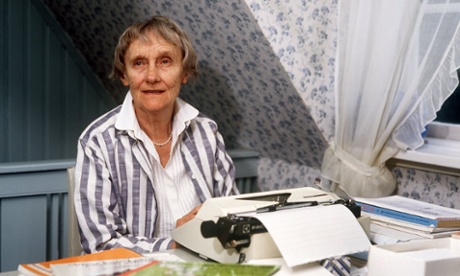
Years before her stories of the red-braided Pippi Longstocking would make her famous, Astrid Lindgren was a 32-year-old mother in Stockholm with two small children, recording the nightmares of the second world war in 17 volumes of diaries that have just been published in Scandinavia for the first time.
Documenting the progress of war and how it affected her family life, the diaries run from 1 September 1939 until the end of hostilities in 1945 – the year that the publication of Pippi Longstocking would change the Swedish author’s life for good. It took a team led by Lindgren’s granddaughter Annika Lindgren two years to turn the 17 handwritten volumes into the just-published Krigsdagböcker (War Diaries). The book includes facsimile images of the pages, which Lindgren peppered with press cuttings, as well as unpublished family photographs from the war years.
“The family has always known about her diaries. We have always thought, what a pity it was that we couldn’t show them to more people, but we considered it impossible on account of their cumbersome size. At last we decided that her notes without the cuttings are interesting enough to publish. They make a coherent story,” said Lindgren’s daughter, Karin Nyman, the original audience for Lindgren’s tales of the mischievous Pippi.
“They make fascinating reading, these records of happenings in a neutral, non-belligerent country, squeezed in between Hitler- or Stalin-attacked or occupied countries. Spared, but often in anguish,” said Nyman. “It seemed timely [to publish this year], 70 years after the peace of 1945.”
The diaries, Nyman added, were kept by her mother “in an old chip basket, originally used as a vessel for sending food supplies from Astrid’s parents on their farm, things like eggs, butter, bread, that were scarce in Stockholm during the war.”
“Oh! War broke out today. Nobody could believe it,” writes Lindgren on 1 September 1939. “Yesterday afternoon, Elsa Gullander and I were in Vasa park with the children running and playing around us and we sat there giving Hitler a nice, cosy telling off and agreed that there definitely wasn’t going to be a war – and now today! The Germans bombarded several Polish cities early this morning and are forging their way into Poland from all directions. I have managed to restrain myself from any hoarding until now, but today I laid in a little cocoa, a little tea, a small amount of soap and a few other things.”
A “terrible despondency” is “weighing on everything and everyone”, she goes on, in a translation by Sarah Death. “The radio churns out news reports all day long. Lots of our men liable for military service are being called up. A ban has been imposed on private motoring. God help our poor planet in the grip of this madness!”
Six years later, on 7 May 1945, she celebrates: “The war is over! The war is over! The war is over!”, writing of the “wild sense of jubilation” on the streets of Stockholm, where “everyone’s behaving as if they’ve gone crazy”.
“I’ve been drinking sherry with Linnea and Lars and feel a bit light-headed,” she continues. “It’s spring and the sun is shining on this blessed day and the war is over. I wouldn’t want to be German. Just think, the war’s over, Hitler’s dead (there are jubilant shouts and cheers on the radio now; Stockholm has completely taken leave of its senses).”
There is no English publisher lined up as yet for the diaries, but reviews in the Scandinavian press have called them an “unparalled war narrative”, “unprecedented”, and a “shocking history lesson”, bringing to life the housewives hoarding soap and eggs in Stockholm as well as being a “meticulous” reporting of the war featuring newspaper clippings, maps and photographs.
Described as a “very personal account of how dramatic world events affect us all” by their Swedish publisher Salikon, which says the text is “laden with sadness and dismay”, the diaries show everything from Lindgren’s horror at the deportation of 1,000 Norwegian Jews to Poland – “it is diabolical!” – to her personal heartbreak after a marriage crisis. “Blood is flowing, people are maimed, misery and despair are everywhere. And I don’t care about it. Only my own problems interest me,” wrote the Swedish author in July 1944.
The diaries also cover the period she worked at Sweden’s Special Intelligence Agency in the mail censorship office, reading overseas correspondence and other military mail. Lindgren had previously worked as a journalist and a secretary, leaving her home town of Vimmerby after she became pregnant and moving to Stockholm. She met the man who would become her husband, Sture Lindgren, while working as a stenographer at the Royal Automobile Club, going on to concentrate on her role as wife and mother while still writing short stories for a magazine.
“[The diary] gives us an enhanced picture of Astrid Lindgren’s authorship. At 32 years of age, she was not an established writer, no books published, but her style, when documenting and commenting, is mature and fully recognisable as hers; emphatic and humorous at the same time, down-to-earth,” said Nyman. “We publish all her own words, but have to do without the major part of the press cuttings, otherwise the bulk would be too enormous.”
Towards the end of the diaries, in 1944, there are notes about Lindgren “amusing” herself with Pippi Longstocking, her children’s character, whose stories would go on to sell more than 60m copies around the world, in more than 70 languages.
Between 1944 and 1946, Lindgren would write six children’s books, going on to work on her stories at home in bed in the mornings, and working for the publishing firm Rabén & Sjögren – which published her own titles – as an editor in the afternoons.
She died in 2002 at the age of 94, one of Sweden’s best-loved authors and the author of more than 100 books, and was also famous as an advocate of children’s welfare and animal rights.

